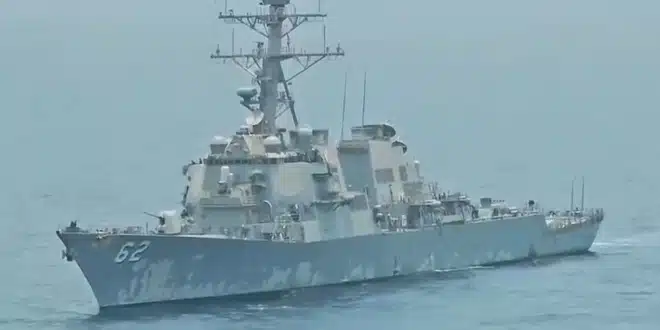Tensions between Iran and the United States flared again this week following a maritime encounter in the Gulf of Oman.
According to Iranian state television, Iranian military forces issued a warning to a U.S. Navy destroyer, the USS Fitzgerald, to stay clear of waters claimed by Tehran. While Iranian media portrayed the event as a successful show of force, a U.S. defense official downplayed the incident, describing the interaction as routine and without consequence.
The exchange occurred Wednesday morning when an Iranian army helicopter reportedly flew over the USS Fitzgerald as it was operating near Iranian-claimed waters. State TV asserted that the American vessel attempted to encroach on territory monitored by Iran, prompting the flyover and warning.
Conflicting Narratives Emerge from Both Sides
In its coverage, Iranian media broadcast a video appearing to show the scene from the perspective of the helicopter pilot, who can be heard instructing the U.S. warship to change direction. The report claimed that the destroyer initially responded with its own warnings but ultimately “gave in” and altered its course away from Iranian territorial waters.
“The Iranian pilot… reiterated the warning to stay away,” the broadcaster stated, framing the encounter as a clear assertion of Iranian sovereignty.
However, a U.S. defense official offered a sharply different interpretation. Speaking anonymously, the official said, “The USS Fitzgerald had a safe and professional interaction with an Iranian SH-3 ‘Sea King’ helicopter while operating in international waters.” The official emphasized that the destroyer remained in international waters throughout the episode and that “any reports claiming otherwise are falsehoods.”
The Pentagon also made clear that the interaction did not interfere with the ship’s mission, dismissing Iranian claims that the destroyer was forced to retreat.
Regional Tensions Contextualize Naval Encounters
This incident comes just one month after U.S. forces conducted airstrikes targeting three major Iranian nuclear sites during a 12-day conflict involving Israel and Iran. That escalation followed a broader uptick in hostilities across the Middle East, intensifying friction in the already volatile Gulf waters.
Iran and the United States have a history of confrontations in the region’s maritime corridors, particularly in the Gulf of Oman and the Strait of Hormuz — both of which are strategically vital for global oil shipments. Iranian forces have frequently challenged U.S. naval movements near their coastline, often using flyovers or small patrol boats to signal their presence.
One notable case occurred in 2023, when Iran claimed it forced a U.S. submarine to surface as it crossed the Strait of Hormuz. The U.S. Navy flatly rejected that account, underscoring the deep distrust and competing narratives that regularly define encounters between the two militaries.
Strategic Implications
Although this latest interaction appears to have concluded without direct confrontation or escalation, it underscores the fragile nature of maritime security in the Gulf. With geopolitical tensions still high following recent military actions and long-standing disputes over territorial waters, even brief encounters like this one carry the potential to spiral if mismanaged.
As both nations maintain strong naval presences in the region, the likelihood of future interactions remains high. The incident serves as a reminder of the delicate balancing act underway in a region where a single miscommunication could have broader consequences.


